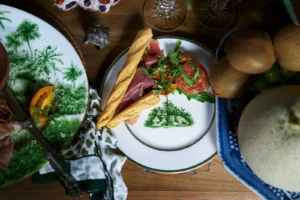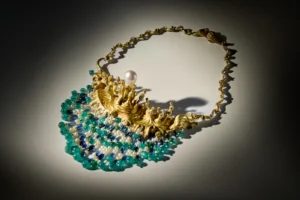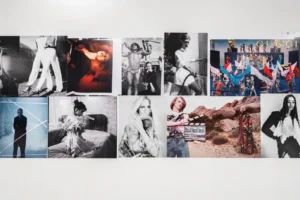In 2020, Indian auction house AstaGuru sold a Pichwai painting on cloth for ₹ 6,81,904. It was initially estimated at ₹ 5,50,000. Moving forward, Christie’s auctioned a Pichwai painting depicting Sharad Purnima for US$ 25,200, in 2023, when it was estimated at roughly US$ 15,000. The high realisation of Pichwais at auctions have signaled a larger trend – this age-old art form is making a comeback.
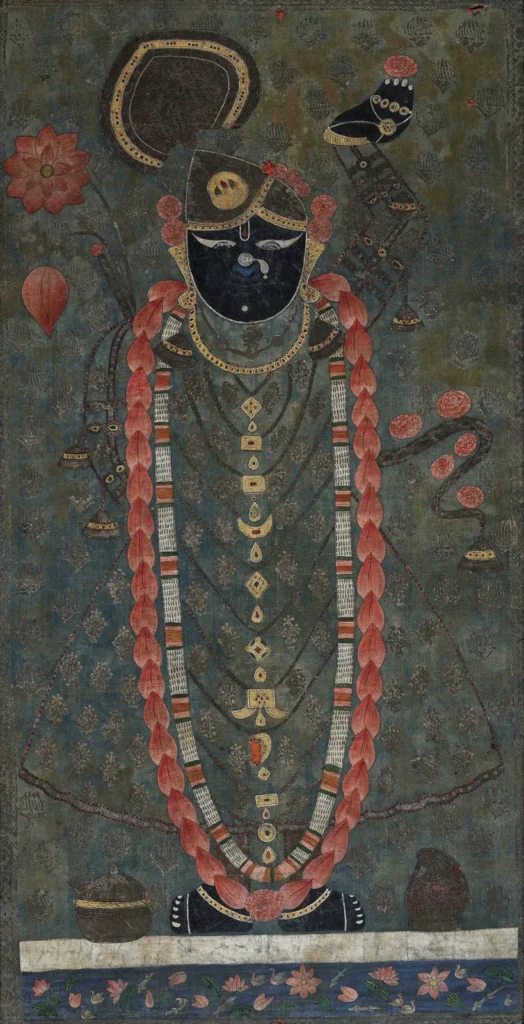
Pichwai art is characterized by a rich repertoire of recurring iconographic motifs, most notably lotuses and cows, which accompany the central figure of Shrinathji in traditional compositions. In addition to these devotional elements, the genre encompasses temple-scapes, architecturally inflected renderings marked by a pronounced geometric formalism.
With its intricate detailing and rich cultural symbolism, Pichwai is being reimagined in modern decor as a timeless celebration of Indian heritage. In today’s interiors, it brings a sense of spiritual elegance and traditional charm to contemporary spaces.
The comeback
“While we do not have consolidated figures across the industry, we’ve observed a growing interest through our auctions and internal data. Several factors are driving this trend—particularly the resonance of Pichwai’s religious themes in a culturally rooted country like India. Additionally, there’s a visible rise in demand from the Indian diaspora, especially collectors based overseas who see Pichwai art as a way to preserve and celebrate their cultural identity. This increasing global appeal has translated into higher bidding activity and more consignments of such works in our auctions,” says Sunny Chandiramani, Director – Client Relations at AstaGuru Auction House.
We’ve seen this art flourish on cushions, crockery, and decorative wall plates, allowing it to move fluidly between tradition and modern design sensibilities.
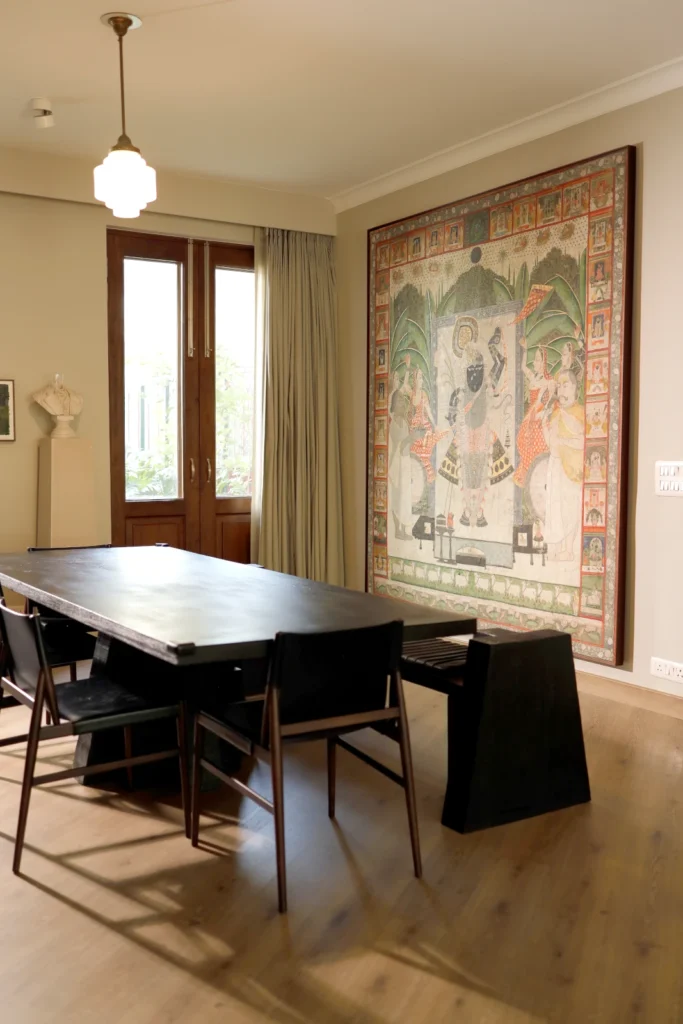
The breadth and depth of the Pichwai tradition, combining symbolic resonance with aesthetic intricacy, render it accessible on multiple levels of appreciation, thereby contributing to its enduring appeal. This is also fueling an interest from contemporary artists to reintroduce the Pichwai art form into current consciousness. “They’ve [contemporary collectors] inspired several modern and contemporary Indian artists such as Jayasri Burman, Sital Chandra Bandyopadhyay, and T. Vaikuntam, who have drawn from the Pichwai idiom in their own practice. This growing artistic and curatorial interest indicates that Pichwai paintings are transitioning into a long-term trend within the art ecosystem,” explains Ms. Chandiramani.
Taking advantage of the renewed enthusiasm for Pichwai art, home decorators are now revitalising this art form to incorporate it into living spaces in all its glory. Apart from the traditional renderings of the form, there are many nuances that have been brought about, with beautiful colors that include touches of gold and silver. “At my atelier, there are several reimaginings of the art form that I conceptualized, including the Chowbees Swaroop (24 avatars of Lord Krishna) in greyscale, or a traditional pichwai painted within a jharoka, an architectural motif of the haveli of Shrinathji. All of these have allowed the art form to fit within versatile home decor options,” says Pooja Singhal, cultural revivalist, and founder, Atelier Pichvai Tradition & Beyond.
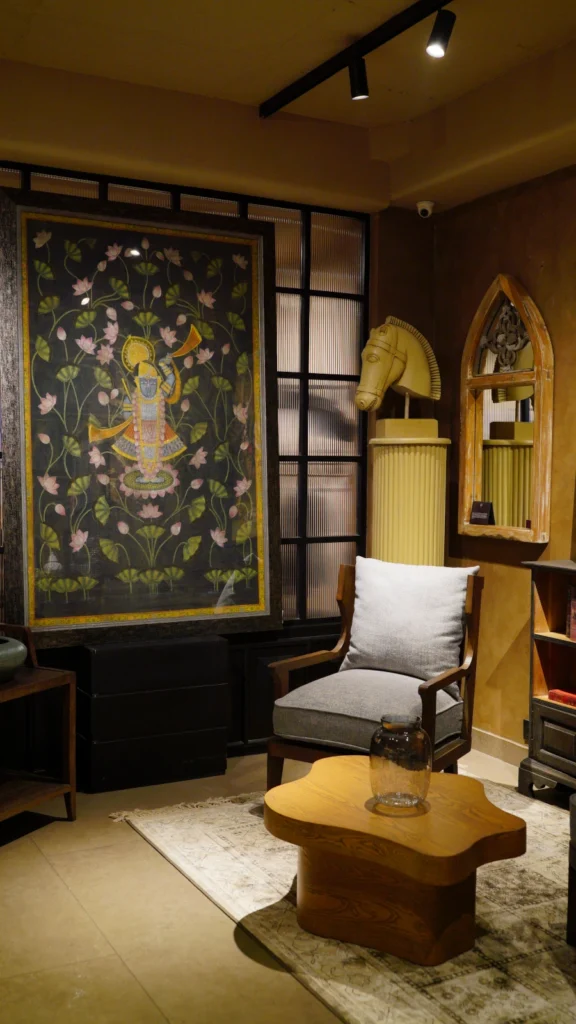
Pichwai, with its minute detailing, is becoming popular both in India and globally. We’ve seen this art flourish on cushions, crockery, and decorative wall plates, allowing it to move fluidly between tradition and modern design sensibilities. Mita Mehta, Founder & Interior Stylist, Mita Mehta Studio, says, “Painted traditionally on cotton or silk, these works often depict scenes from the life of Lord Krishna, particularly the tales of Krishna Leela. Every brushstroke carries a story, making these pieces not just décor, but conversations in art and heritage. Their beauty and rich storytelling lend a soulful character to interiors. Pichwai wall art framed, pichwai wall plates, bespoke wallpaper, crockery, cushions are different ways in which it can be used to enhance the artistic aspect of the space.”
Walls that speak
Pichwai’s growing popularity in home décor stems from its ability to blend intricate artistry with cultural storytelling. The detailed depictions of Krishna’s life, lotuses, and cows evoke a sense of serenity and devotion, offering not just aesthetic appeal but emotional depth. “In a world leaning toward conscious, rooted living, Pichwai brings heritage into homes, making spaces feel both meaningful and visually rich. It’s traditional, yet timeless, perfect for modern Indian interiors seeking soul and identity. UDC Homes beautifully channels this aesthetic through their Pichwai-themed wallpapers, each design thoughtfully crafted to infuse homes with Indian artistry, offering a striking yet soulful visual narrative for walls,” says Neha Jain, Co-Founder UDC Homes.
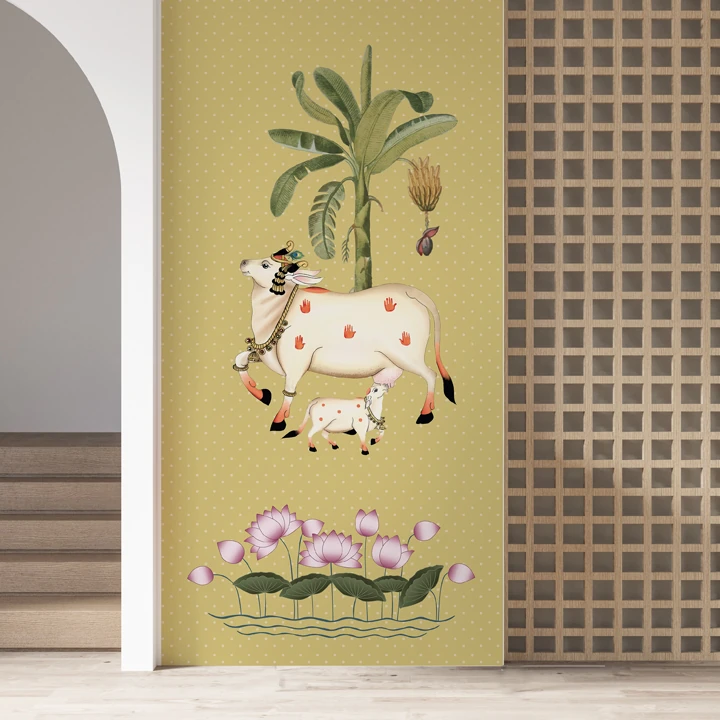
Pichwai-themed wallpapers can be seamlessly integrated into home decor to create spaces that are rooted in Indian tradition yet feel refreshingly modern. These wallpapers work beautifully as feature walls in living rooms, bedrooms, pooja rooms, or even hallways, instantly adding depth, storytelling, and a touch of Indian charm. “What makes them truly versatile is that they can be applied on any textured surface and even customized to suit the specific look and palette of the space. Whether used behind a bed as a headboard backdrop or framed as large panels in a dining room, their timeless elegance elevates any setting. And the beauty lies in how creatively people interpret them, making each application a unique work of art that reflects personal style and cultural heritage,” adds Ms. Jain.
It’s not imperative to use Pichwai painintgs in a traditional, temple-style Indian décor aesthetic. As improbable as it sounds, Pichwai paintings work well with organically flowing architecture, brutalist architecture and straight-lined furniture as well. What it does need to enhance its beauty is a brightly lit room.
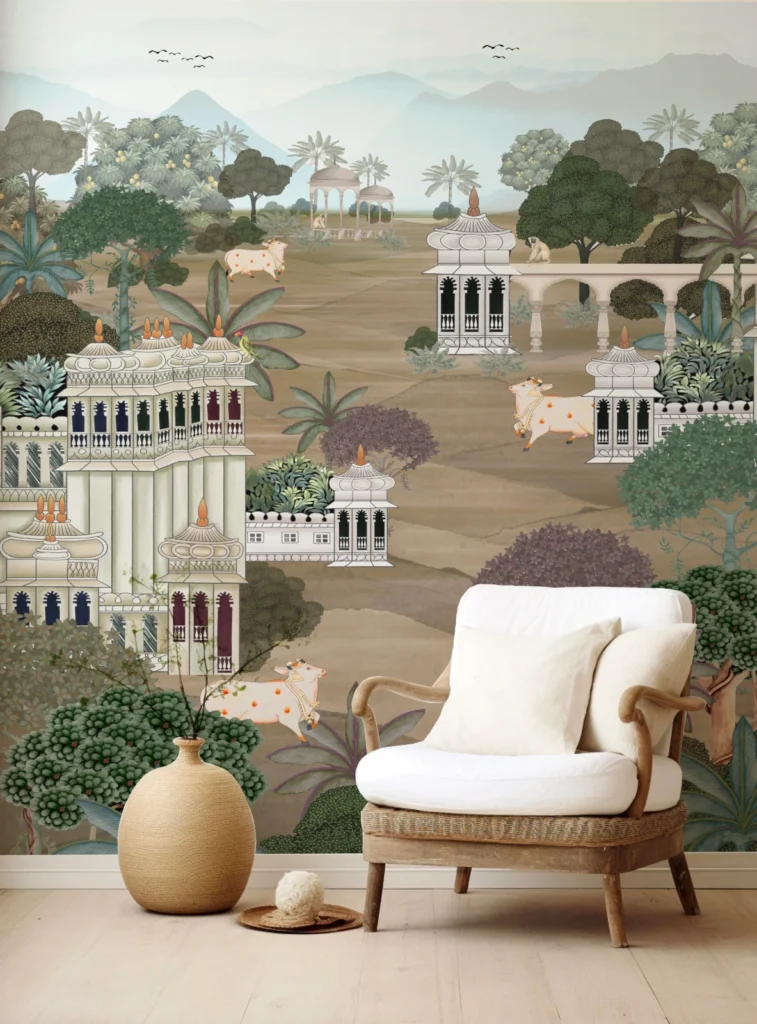
Narrative nuances
In contemporary interiors, there is a growing appreciation for textiles as a narrative tool, whether it’s a woven carpet displayed as wall art or a fabric element that complements the antique vibe. “Pichwai, a traditional painting style executed on fabric, possesses a unique ability to enhance an environment with its storytelling quality. Often abstract, it invites personal interpretation and helps shape the spatial identity of a room. Unlike many traditional artworks, what sets Pichwai apart is its canvas, a fabric that introduces texture, tactility, and depth into interior spaces. Pichwais, done in the traditional style, can be used in mandir design, but the craft is not confined to sacred spaces. By incorporating Western art techniques, Pichwai art has gained global recognition and can now be utilized beyond its traditional sacred context,” say Joya Nandurdikar and Amrita Guha, Founding Partners, Untitled Design.
Pichwai art is evolving from a niche devotional practice into a recognised collectible category.
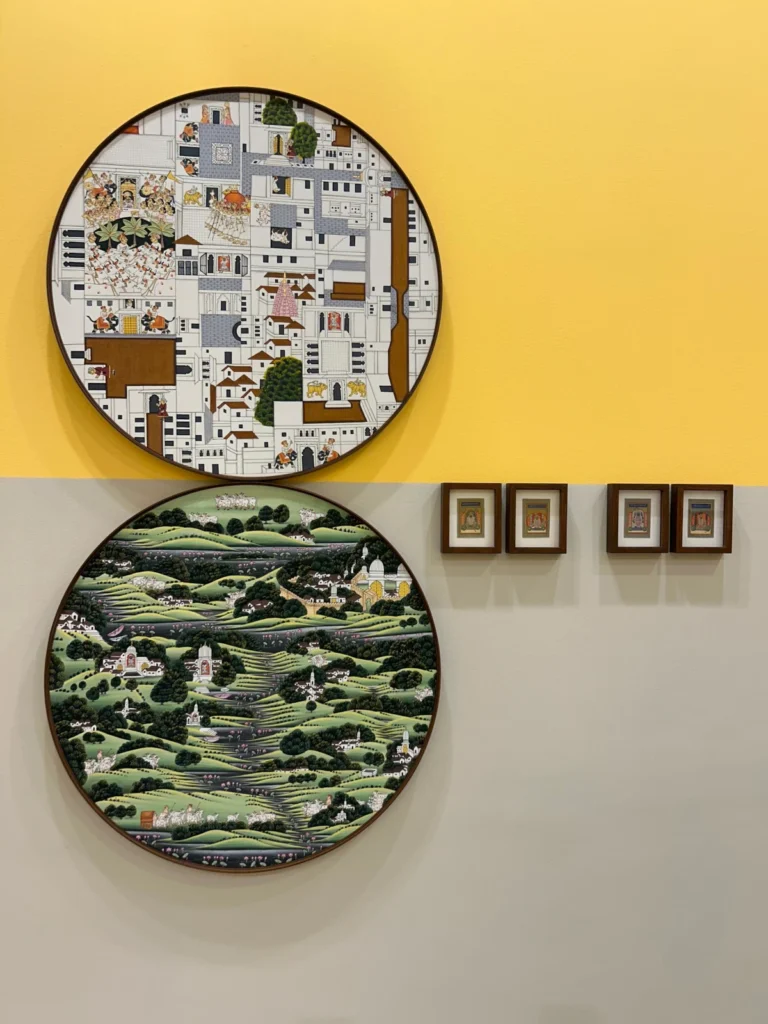
These artworks can be featured as striking statement pieces or wall panels in living rooms or foyers that need a traditional touch. They can also be reinterpreted into furniture design, like on a coffee table surface, where the fine detailing becomes a conversation piece.
Despite its modern adaptations, Pichwai retains deep spiritual significance and should be approached with respect. It can certainly be used as a decorative element, but not in ways that diminish its sacred value, such as a sofa throw or floor rug. It is important to honor the art form, treating it not just as a fabric but as a cultural and religious expression.
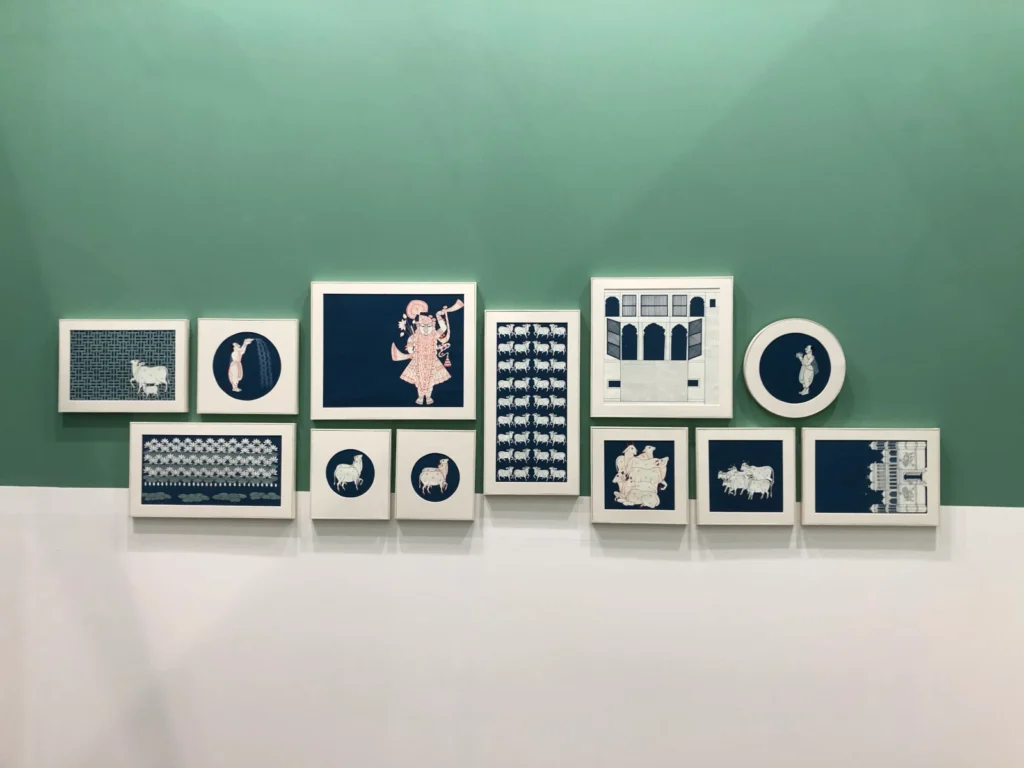
“Pichwai art is evolving from a niche devotional practice into a recognised collectible category. These works are not only deeply spiritual but also visually striking, featuring intricate patterns and vivid colors that appeal to both traditional and contemporary collectors,” says Ms. Chandiramani. So play around with your Pichwais. Whether you place them around soothing water features or in home libraries, Pichwai art brings serenity, combined with aesthetics.
Tips
- Don’t use Pichwai as just another element. Let it be the hero of the space, ideal for accent walls, entryways, or alcoves.
- Pichwai artworks are rich and detailed, so pair them with muted or earthy tones to avoid overwhelming the space.
- Choose a size and position that complement the room’s dimensions, larger pieces for spacious areas, and smaller panels for compact corners.
- Pichwai can work beautifully in contemporary homes when styled thoughtfully with sleek furniture and clean lines.
- Soft, warm lighting can beautifully highlight the intricate details and enhance its traditional charm.
- Avoid placing too many other decorative elements around Pichwai; it deserves visual breathing room.
- Like all art, Pichwai can fade over time if exposed to harsh light; indirect lighting is best.


